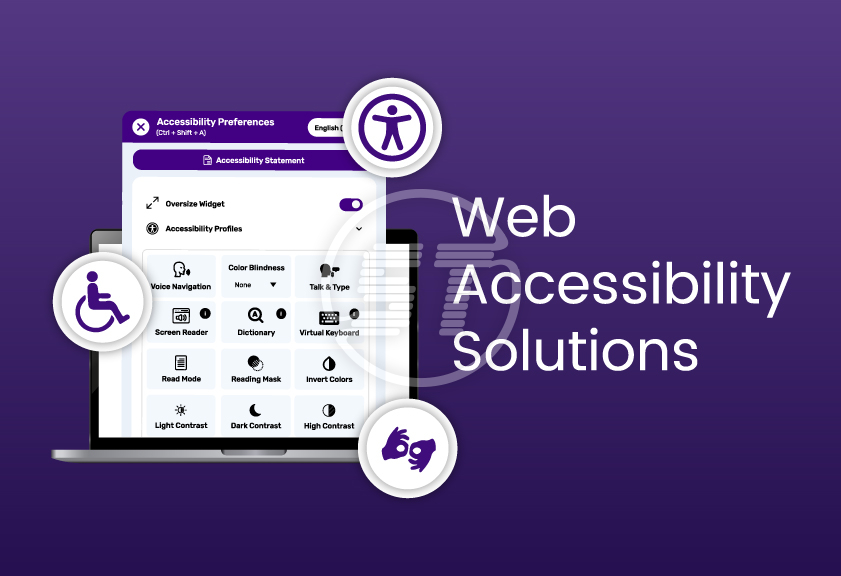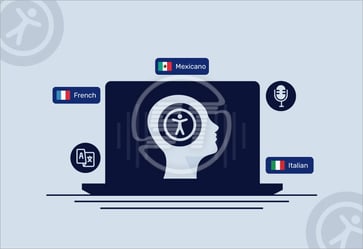Time is running out! The European Accessibility Act (EAA) will be enforced on June 28, 2025. Businesses must ensure that their digital assets for websites, applications, and documents can be accessed by everyone.
The EAA aims to create a digital world for over 100 million people with disabilities in the European Union!
Most business owners don't know what to check to ensure their business complies with EAA mandates. We will get you started with a checklist that will list what to look at and how to start.
This guide will provide you with the critical information, resources, and actions to start your pathway to conforming to the law.
What is the European Accessibility Act?
The European Accessibility Act (EAA) seeks to break down digital barriers and create a common way to ensure accessibility across EU countries. The EAA seeks to strengthen the internal market's ability to deliver accessible products/services by removing the barriers posed by the different laws of member states.
Private sector companies have until 28 June 2025 to ensure that their connected goods and services can be used throughout Europe. This includes websites, applications, e-commerce platforms, banking services, etc.
The EAA seeks more than simply compliance; it seeks all 27 member states to bring together accessibility standards to create a seamless experience for disabled users when moving through the European market.
Who Must Comply with the EAA?
EAA is not applicable to every business. What you provide and the size of your company are the two main determinants of its scope.
Let’s break down these factors:
If your company sells goods or services covered by EAA
Businesses that operate in the EU and provide digital goods, services, or auxiliary technology are expected to adhere to the necessary accessibility standards.
These businesses involve
- Digital markets or online retailers
- Web-based or mobile banking services
- Internet-based messaging or phone-based communication devices
- Platforms for streaming or services for audiovisual content
- E-books and specialized e-reading software
- Systems for reservations, tickets, or real-time transit data
- Self-service terminals, including cash machines or check-in kiosks
- Consumer electronics such as set-top boxes, cellphones, and operating systems
Does your business qualify as a microenterprise?
Microenterprises are defined as businesses with less than ten employees and an annual revenue of €2 million. The EAA's service-related standards are probably not applicable to these microenterprises.
However, if you produce consumer electronics such as smartphones, payment terminals, or other items covered by the EAA. Even if you are considered a microenterprise, you may still have to fulfill some accessibility requirements.
The European Commission maintains a list of national contact points and implementation updates to help you identify which agency is in charge of your nation.
Key Accessibility Requirements Under the EAA
After thoroughly understanding the EAA concept and its target audience, let's examine what compliance entails.
The EAA does not, however, specify a formal requirement for conformity. Strong evidence suggests that EN 301 549 will be used as the standard throughout Europe.
What is EN 301 549?
EN 301 549 is a European standard that defines accessible digital products and services. This could be software, hardware, kiosks, apps, or websites.
It is widely regarded as the minimum technical standard to determine compliance under the EAA, and it has been part of EU public sector accessibility regulations for years.
That said, it does not describe any specifics; it refers to the Web Content Accessibility Guidelines (WCAG). WCAG is a regulatory framework developed by W3C, and it is utilized as a basic accessibility standard by many nations.
All about WCAG
The WCAG is developed on the basis of four key principles, known as POUR, to make digital content accessible.
- Perceivable: Web page content must be easy to consume by people with visual or motor disabilities.
- Operable: All the elements of the webpage should be functional by keyboard or assistive technologies.
- Understandable: Content must be easy to navigate with a keyboard and assistive technologies.
- Robust: The website must be designed in a way that modern devices, browsers, and assistive technologies like screen readers can use it.
The WCAG landscape has three distinct versions—2.0, 2.1, and 2.2. If these are building blocks, then each block is built on top of its predecessors and contains updated criteria. A few areas that are augmented to address newer accessibility challenges are mobile-first design, better support for users with low vision, and enhanced cognitive accessibility features.
It becomes important to understand the three-tier compliance structure:
- Level A represents foundational accessibility—the bare minimum
- Level AA serves as the gold standard that most regulations reference
- Level AAA delivers premium accessibility but proves challenging to implement universally
And here is the exception to the trickery: Most legal frameworks, including the EAA, set themselves against WCAG 2.1 at Level AA standards; that is, if you get your site to Level AA compliance under WCAG 2.1, you will have basically satisfied all your regulatory obligations and will be providing enough accessibility for the vast majority of disabled people.
How to Comply With EAA
To comply with EAA in accordance with WCAG standards, you’ll have to follow a multi-layered approach involving accessibility testing, remediation, and ongoing accessibility maintenance.
Here’s a checklist that’ll assist you in your accessibility journey.
Note: This is not a complete list. You must follow extra rules in order to comply with WCAG 2.1 level AA at the required level.
- Provide alt text for relevant images.
- Verify that the text retains its functionality and substance even when scaled to 200%.
- Make use of clear headings and labeling.
- Provide audio descriptions for video content and include a "Skip to Content" link for convenient access to the main topic.
- Allow users to set time limits for interacting with interactive features on websites.
- Make informative and understandable page titles.
- Make sure the information that color conveys can be identified without color.
- Ensure that all website features are usable by users with restricted mobility.
- Ensure that menus, buttons, and icons display consistently.
- Specify the correct language attribute for web pages.
- As web elements receive input, make sure they stay steady.
- Make sure your website is responsive and free of anything that can cause seizures.
- Indicate any language changes in the code.
- Add captions to audio-visual content.
- Give website users the option to manage automatically playing content; provide transcripts for audio and video content; make sure that the text and background contrast is good; and make sure that changing the text spacing doesn't affect functionality.
- Make sure that every feature of the website can be accessed using a keyboard and that users can utilize screen orientation.
- Give live videos subtitles.
- Make sure that any mistakes are noted and explained in the text.
What You Need To Do Right Now
Before we dive in: If you're reading this and you're feeling overwhelmed, that is normal. Here is your action plan:
- Assess your current situation
You cannot fix what you do not know to be broken. An extensive manual accessibility audit will allow you to identify any gaps regarding your situation; it will even enable you to prioritize your fixes by impact/effort required to facilitate changes now.
- Know your technical requirements
Make yourself familiar with the WCAG 2.2 checklist and the implications it has for your digital properties. This is not just for websites. You need to consider all digital touchpoints for users.
- Create a remediation plan
You do not need to fix everything at once, but you need to plan where you are going and the time during which you will commit resources (including people) to remediating by June. For now, focus on the primary user journeys.
- Train your teams
Your development, design, and content teams need to understand accessibility principles. This is not a one-off fix; it is a practice that you need to continue in your processes.
- Consider using professional services
Given the complexities and time pressures, many organizations have pursued web accessibility solutions as they offer confidence that they are meeting criteria without losing focus on development priorities.
Amp Up Your Accessibility Compliance With AI
By leveraging All in One Accessibility widget, you can streamline your compliance efforts. This is an AI-powered tool that improves website accessibility for disability communities. All In One Accessibility has a wide array of features that make websites usable for persons with disabilities, like
- Visual or motor impairments,
- Cognitive or learning disabilities,
- ADHD,
- Epilepsy, and
- Color blindness.
Extra features are allowed for customization, as users can simply choose how they want to browse the web.
Wrapping Up
The clock is ticking!
With just a few days left until the EAA deadline becomes reality, now is the time to act. For businesses that are willing to commit the right resources and approach this systematically, it’s still entirely achievable. Start your accessibility assessment today. Then build a focused remediation plan that addresses critical gaps before June 28, 2025.
At Skynet Technologies, our web accessibility solutions go far beyond box-ticking—they’re designed to build long-term, scalable digital inclusion.
Here’s how we can support your journey:
- All in One Accessibility widget: An AI-powered tool to instantly enhance your website’s accessibility for people with visual, motor, cognitive, and other disabilities
- Website accessibility audits: Manual (human) accessibility audit, automated accessibility audits, and semi-automated (hybrid) accessibility audits
- VPAT Report and ACR: Accessibility Conformance Reports to demonstrate your compliance
- Accessibility scanning and monitoring: Ongoing tools to detect new accessibility issues as your website evolves
It’s not just about compliance; it’s about future-proofing your brand and opening your digital doors to millions more users.
What sets us apart?
Whether you're a government agency looking to fulfill a public sector obligation, an enterprise business that needs to create accessibility within complex internal systems, or an e-commerce platform servicing millions of customers.
We tailor accessibility solutions to fit your specific goals, scale, and timeline.
Contact us or email us at [email protected]. Because when it comes to accessibility compliance, the best time to start was yesterday. Let's make sure your business is prepared for the accessible community of the future, launching on June 28, 2025.


